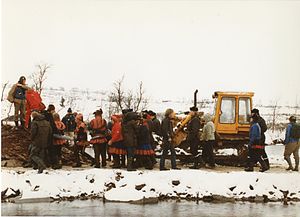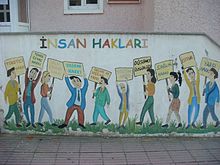
The Romani, also spelled Romany or Rromani and colloquially known as the Roma, are an ethnic group of Indo-Aryan origin who traditionally lived a nomadic, itinerant lifestyle. Linguistic and genetic evidence suggests that the Romani originated in the Indian subcontinent, in particular the region of present-day Rajasthan. Their subsequent westward migration, possibly in waves, is now believed by historians to have occurred around 1000 CE. Their original name is from the Sanskrit word डोम, ḍoma and means a member of the Dom caste of travelling musicians and dancers. The Roma population moved west into the Ghaznavid Empire and later into the Byzantine Empire. The Roma are thought to have arrived in Europe around the 13th to 14th century. Although they are widely dispersed, their most concentrated populations are located in Bulgaria, Hungary, Romania, Spain, and Turkey.

Romani music is the music of the Romani people who have their origins in northern India but today live mostly in Europe.
The Dom are descendants of the Dom caste with origins in the Indian subcontinent which through ancient migrations are found scattered across the Middle East and North Africa, the Eastern Anatolia Region, and parts of the Balkans and Hungary. The traditional language of the Dom is Domari, an endangered Indo-Aryan language, thereby making the Dom an Indo-Aryan ethnic group.

Roma, traditionally Țigani, constitute one of Romania's largest minorities. According to the 2011 census, their number was 621,573 people or 3.3% of the total population, being the second-largest ethnic minority in Romania after Hungarians. There are different estimates about the size of the total population of people with Romani ancestry in Romania, varying from 4.6 per cent to over 10 percent of the population, because many people of Romani descent do not declare themselves Roma. For example, in 2007 the Council of Europe estimated that approximately 1.85 million Roma lived in Romania, based on an average between the lowest estimate and the highest estimate available at the time. This figure is equivalent to 8.32% of the population.

The Romani people are a distinct ethnic and cultural group of peoples living all across the globe, who share a family of languages and sometimes a traditional nomadic mode of life. Though their exact origins are unclear, central India is a notable point of origin. Their language shares a common origin with, and is similar to, modern-day Gujarati and Rajasthani, borrowing loan words from other languages as they migrated from India. In Europe, even though their culture has been victimized by other cultures, they have still found a way to maintain their heritage and society. Indian elements in Romani culture are almost non-existent, with the exception of their language. Romani culture focuses heavily on family. The Roma traditionally live according to relatively strict moral codes. The ethnic culture of the Romani people who live in central, eastern and southeastern European countries developed through a long, complex process of continuous active interaction with the culture of their surrounding European population.

Romani people in Bulgaria constitute Europe's densest Roma minority. The Romani people in Bulgaria may speak Bulgarian, Turkish or Romani, depending on the region.

Anti-Romani sentiment is a form of bigotry which consists of hostility, prejudice, discrimination, racism and xenophobia which is specifically directed at Romani people. Non-Romani itinerant groups in Europe such as the Yenish, Irish and Highland Travellers are frequently given the name "gypsy" and as a result, they are frequently confused with the Romani people. As a result, sentiments which were originally directed at the Romani people are also directed at other traveler groups and they are frequently referred to as "antigypsy" sentiments.
The following outline is provided as an overview of and guide to forestry:
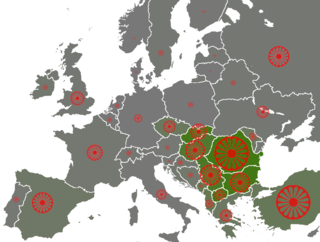
The Romani people have several distinct populations, the largest being the Roma and the Calé, who reached Anatolia and the Balkans in the early 12th century, from a migration out of the Indian subcontinent beginning about 1st century – 2nd century AD. They settled in the areas of present-day Turkey, Greece, Serbia, Romania, Croatia, Moldova, Bulgaria, North Macedonia, Hungary, Albania, Kosovo, Bosnia and Herzegovina, Czech Republic, Slovenia and Slovakia, by order of volume, and Spain. From the Balkans, they migrated throughout Europe and, in the nineteenth and later centuries, to the Americas. The Roma population in the United States is estimated at more than one million.
Romani people, or Roma, are the fourth largest ethnic group in Serbia, numbering 131,936 (1.98%) according to the 2022 census. However, due to a legacy of poor birth registration and some other factors, this official number is likely underestimated. Estimates that correct for undercounting suggest that Serbia is one of countries with the most significant populations of Roma people in Europe at 250,000-500,000. Anywhere between 46,000 to 97,000 Roma are internally displaced from Kosovo after 1999.
Romani hip hop is a musical genre from Eastern Europe, formed through a fusion of hip hop with Romani melodies and lyrics.

This is a list of dances of the Romani people.
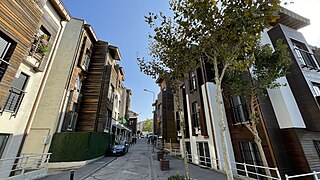
Sulukule is a historic quarter in the Fatih district of Istanbul, Turkey. It is within the area of Istanbul’s historic peninsula, adjacent to the western part of the city walls. The area has historically been occupied by Romani communities. Roma presence in this part of Istanbul dates back to Byzantine times, while it is in the 15th century, upon Ottoman conquest, that the quarter became (reportedly) the first district in the world permanently settled by sedentary Romani people in Turkey.
The Romani people of Greece, or Romá, are called Tsinganoi, Athinganoi (Αθίγγανοι), or the more derogatory term Gyftoi. On 8 April 2019, the Greek government stated that the number of Greek Roma citizens in Greece is around 110,000. Other estimates have placed the number of Romani people resident in Greece as high as 350,000.
Its members are referred to as Turkish Gypsy, Türk Çingeneler, Turski Tsigani, Turkogifti (τουρκο-γύφτοι), Țigani turci, Török Cigányok, Turci Cigani. Through self-Turkification and Assimilation in the Turkish culture over centuries, this Muslim Roma have adopted the Turkish language and lost Rumelian Romani language, in order to establish a Turkish Identity to become more recognized by the Host population and deny their Romani background to show their Turkishness. At Population Census they declared themself as Turks instead as Roma and said How happy is the one who says I am a Turk, however, Turks consider them as fake-Turks, and Christian Romani do not consider them as part of the Romani society. They are Cultural Muslims who adopted Sunni Islam of Hanafi madhab and Religious male circumcision at the time of the Anatolian Seljuk Sultanate and Ottoman Empire. Their legendary leader was Mansur ibn Yakub Han, called Çingene Han. He built his karavansaray in Malatya in 1224. Today it can still be seen as a ruin. Mansur bin Yakup Han is buried in the Ulu Mosque in Malatya.

Muslim Romani people are people who are ethnically Roma and profess Islam. There are many different Roma groups and subgroups that predominantly practice Islam, as well as individual Romani people from other subethnic groups who have accepted Islam. Xoraxane Roma in Balkan Romani language, are non-Vlax Romani people, who adopted Sunni Islam of the Hanafi madhhab at the time of the Ottoman Empire. Some of them are Derviş of Sufism belief, and the biggest Tariqa of Jerrahi is located at the largest Arlije and Gurbeti Muslim Roma settlement in Europe in Šuto Orizari, locally called Shutka in North Macedonia have their own Romani Imam and the Muslim Roma in Šuto Orizari use the Quran in Balkan Romani language. Many Romanlar in Turkey, are members of the Hindiler Tekkesi a Qadiriyya-Tariqa, founded in 1738 by the Indian Muslim Sheykh Seyfullah Efendi El Hindi in Selamsız. Roma Muslims in Turkey and the Balkans are mostly cultural Muslims or nominal Muslims.
The Romani people in Turkey or Turks of Romani background are Turkish citizens and the biggest subgroup of the Turkish Roma. They are Sunni Muslims mostly of Sufi orientation, who speak Turkish as their first language, in their own accent, and have adopted Turkish culture. Many have denied their Romani background over the centuries in order to establish a Turkish identity, to become more accepted by the host population. They identify themselves as Turks of Oghuz ancestry. More specifically, some have claimed to be members of the Yörüks, Amuca, Gajal or Tahtacı.
Sepečides Romani, also known as Sevlengere Roma, is the Romani dialect of the traditionally basketweaving Roma originally from Thessaloniki. Their ancestors lived there as nomads during the Ottoman Empire until the population exchange between Greece and Turkey. The Sepečides dialect is considered to be non-Vlax. It belongs to the Southern Balkan group of Romani dialects, although the RomArchive claims the language is practically extinct.
Environmental racism is a form of institutional racism leading to landfills, incinerators, and hazardous waste disposal being disproportionally placed in communities of colour. This includes the lack of minority and indigenous representation in environmental decision-making and inequality in resource development. Internationally, it is also associated with extractivism, which places the environmental burdens of mining, oil extraction, and industrial agriculture upon Indigenous peoples and poorer nations largely inhabited by people of colour.
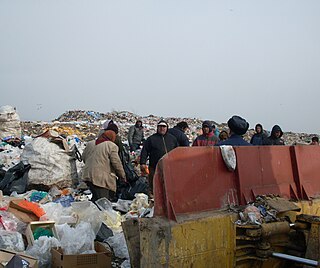
Environmental racism in Central and Eastern Europe is well documented. In Central and Eastern Europe, socialist governments have generally prioritized industrial development over environmental protection, in spite of growing public and governmental environmental awareness in the 1960s and 1970s. Even though public concern over the environmental effects of industrial expansion such as mine and dam construction grew in the late 1980s and early 1990s, policy makers continued to focus on privatization and economic development. Following the market transition, environmental issues have persisted, despite some improvements during the early stages of transition. Throughout this time, significant social restructuring took place alongside environmental changes.
